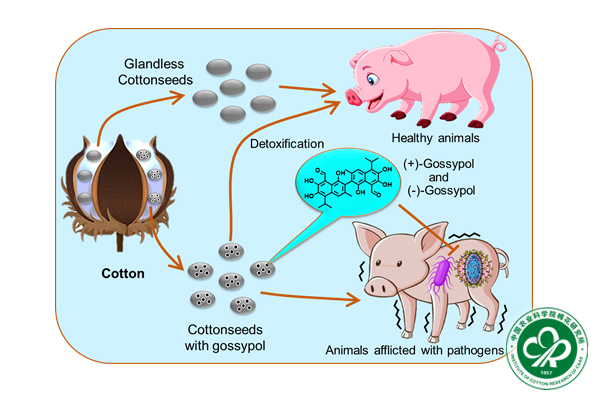- Location : Home» Newsroom
Professor FuguangLi's team proposes the comprehensive utilization of cottonseeds
Recently, Prof. FuguangLi's team at the Cotton Research Institute of the Chinese Academy of Agricultural Sciences conducted an extensive review and forward-looking analysis of cottonseed's utilization in animal feed, across various scenarios. Their review article, titled 'Utilizing Cottonseed in Animal Feeding: A Dialectical Perspective,' has been published in the 'Modern Agriculture' journal, providing novel insights for the comprehensive utilization of cottonseeds.
Cotton is a globally significant economic crop, yielding products such as fiber, cottonseeds, cotton straw, and secondary metabolites. Cottonseed meal, a by-product extracted after processing cottonseed oil, is rich in crude protein and a variety of amino acids, making it a premium protein feed ingredient. Traditional research has long indicated that cottonseeds contain a toxic compound, gossypol, which has impeded the effective utilization of cottonseed meal in livestock and poultry feed. Whilegossypol exhibits broad-spectrum antiviral properties against animal viruses, introducing new possibilities for the holistic use of cottonseeds.
In this paper, the authors systematically outline that the demand for animal products, including meat, eggs, and milk, has risen dramatically with the expanding global population. This has propelled the rapid growth of animal husbandry. However, the swift urbanization has led to intensified animal farming, giving rise to two major challenges for the sustainable development of animal husbandry: shortages in protein resources and the widespread prevalence of infectious diseases. In terms of protein resources, China faces a severe lack of both quantity and diversity, and the protein resources is underutilized. To combat infectious diseases in livestock and poultry, antibiotics and antiviral drugs are used, but their excessive application can lead to drug residues, environmental pollution, and pose serious risks to human health.
Cottonseed meal boasts high protein content and a rich array of nutrients, such as fats, cellulose, and minerals, making it a high-quality feed ingredient. However, the presence of gossypol has restricted its use in animal feed. On the bright side, gossypol exhibits inhibitory effects on various pathogenic microorganisms from diverse hosts, with pronounced broad-spectrum inhibitory activity against animal and human coronaviruses. Furthermore, gossypol has a chiral axis, resulting in two enantiomers: (-)-gossypol and (+)-gossypol, each with distinct activities and toxicities. This opens the door to multiple possibilities for applying cottonseeds in various contexts.
In this paper, the authors proposethe utilization of cottonseeds across different scenarios to address protein shortages in livestock and poultry farming. Cottonseeds containing gossypol, after amino acid balancing, can be harnessed to create high-quality daily feed for animal husbandry. Gossypol can serve as a natural additive for cottonseed meal feed, offering a short-term emergency solution for the prevention and treatment of infectious diseases in livestock and poultry. Given its lower toxicity and the capacity to inhibit pathogenic microorganisms, (+)-gossypol holds significant potential in the 'homology of medicine and feed' within cottonseed meal. This research significantly contributes to promoting the high-value utilization of cottonseeds in livestock and poultry farming.
Dr. WenjingWang and Dr. JunLi, both young faculty members at Zhengzhou University's College of Agriculture, are co-first authors of the paper. Prof. FuguangLi from the Cotton Research Institute of the Chinese Academy of Agricultural Sciences and Prof. Maozhi Ren from the Institute of Urban Agriculture, Chinese Academy of Agricultural Sciences, serve as corresponding authors. Juncheng Liu, a graduate student at Zhengzhou University's College of Agriculture, also makes a significant contribution to this research.This study was supported by grants from the National Natural Science Foundation of China, National Key R&D Program of China, Agricultural Science and Technology Innovation Program of the Chinese Academy of Agricultural Sciences (CAAS), Key Science and Technology Research of Henan Province, Nanfan special project and the China Postdoctoral Science Foundation.
